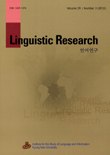- 영문명
- 발행기관
- 경희대학교 언어정보연구소
- 저자명
- YoungEun Yoon
- 간행물 정보
- 『언어연구』제29권 제3호, 485~513쪽, 전체 29쪽
- 주제분류
- 인문학 > 언어학
- 파일형태
- 발행일자
- 2012.12.31

국문 초록
영문 초록
As is well known, the English present perfect incorporates temporal anteriority as part of its meaning. However, such conflicting phenomena like the ‘definiteness effect’ and the ‘lifetime effect’ are observed, along with the pastness of the perfect. In this context, a variety of theories utilizing concepts such as ‘indefinite past,’ ‘perfect state,’ and ‘extended now’ have been proposed as major theories on the perfect among others, but not without theoretical defects. Recently, Meyer-Viol and Jones (2011) also propose a formal account of the English present perfect and simple past tense, based on the notions of ‘reference time,’ ‘event time,’ and ‘speech time.’ They account for the definiteness effect and the lifetime effect by analyzing the perfect to have its reference time at the speech time, while the simple past tense to have its reference time at the event time, in line with Reichenbach(1947). Given this, it is proposed in this paper that these previous theories and observations including Meyer-Viol and Jones’s generalizations are met with numerous counterexamples, and that the difference between the English perfect and simple past should be accounted for by classifying the English perfect into the three uses, i.e., Experientials, Resultatives, and Universals. In addition to the semantics of the three uses of the perfect, pragmatic competition between the perfect and simple past is proposed to play a role in deciding which of the two constructions should be chosen, in line with Schaden (2009).
목차
1. Introduction
2. Previous theories of the perfect
3. MV & J’s analysis
4. Counterexamples to MV & J’s analysis
5. A new analysis
6. Conclusion
References
키워드
해당간행물 수록 논문
참고문헌
최근 이용한 논문
교보eBook 첫 방문을 환영 합니다!

신규가입 혜택 지급이 완료 되었습니다.
바로 사용 가능한 교보e캐시 1,000원 (유효기간 7일)
지금 바로 교보eBook의 다양한 콘텐츠를 이용해 보세요!



